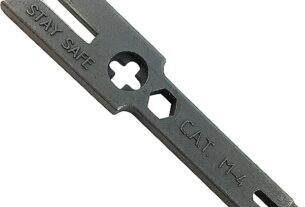The COVID-19 pandemic has changed the way we interact with the world around us. From wearing masks to practicing social distancing, we are all taking steps to protect ourselves and others from this highly contagious virus. One of the most effective tools in the fight against COVID-19 is the use of no touch tools. These innovative gadgets allow us to avoid touching high-contact surfaces like doorknobs, elevator buttons, and ATMs, reducing our risk of exposure to the virus.
In this article, we will explore everything you need to know about no touch tools. From their benefits to how they work, we’ve got you covered. So let’s dive in!
What Are No Touch Tools?
No touch tools are small devices designed to help people avoid touching common surfaces that could be contaminated with germs or viruses. They come in various shapes and sizes but typically feature a hook-like end that allows users to open doors, push buttons, and perform other tasks without using their hands.
How Do No Touch Tools Work?
Most no touch tools are made of metal or plastic and are designed to be easily carried on a keychain or in a pocket. To use one, simply insert the hook-like end into the opening of a door handle or press it against a button, then pull or push as needed. Some models also include flat ends that can be used for swiping credit cards or touching screens.
What Are the Benefits of No Touch Tools?
There are many benefits to using no touch tools, especially during the COVID-19 pandemic. Here are just a few:
1. Reduced Risk of Exposure
Perhaps the most significant benefit of using no touch tools is that they can help reduce your risk of exposure to germs and viruses. By avoiding contact with high-touch surfaces like doorknobs and elevator buttons, you can minimize your chances of coming into contact with the COVID-19 virus or other harmful pathogens.
2. Convenience
No touch tools are incredibly convenient to use. They are small and lightweight, making them easy to carry around with you wherever you go. You won’t have to worry about forgetting your tool at home or fumbling around in your pockets for it when you need it most.
3. Cost-Effective
No touch tools are also cost-effective. Many models are available for under $10, making them an affordable option for people on a budget.
4. Environmentally Friendly
By using a no touch tool instead of disposable gloves or wipes, you can reduce your environmental impact. No touch tools can be cleaned and reused multiple times, meaning less waste ends up in landfills.
5. Versatility
No touch tools can be used for a wide variety of tasks, from opening doors to pressing elevator buttons to carrying grocery bags. Their versatility makes them a valuable tool to have on hand in any situation.
Are No Touch Tools Effective?
Yes! Studies have shown that the COVID-19 virus can survive on surfaces like doorknobs and elevator buttons for several hours, making these high-touch areas potential sources of infection. By using a no touch tool, you can avoid touching these surfaces directly, reducing your risk of exposure to the virus.
What Types of No Touch Tools Are Available?
There are many different types of no touch tools available on the market today. Some of the most popular options include:
1. Keychain Tools
Keychain tools are small devices designed to be carried on a keyring or in a pocket. They typically feature a hook-like end that allows users to open doors and press buttons without touching them directly.
2. Stylus Pens
Stylus pens are another type of no touch tool that is becoming increasingly popular during the COVID-19 pandemic. These pens feature a rubber or plastic tip that can be used to touch screens and other surfaces without using your fingers.
3. Door Handle Hooks
Door handle hooks are designed to be inserted into the opening of a door handle, allowing users to pull or push the door without touching it directly. These hooks are typically made of metal or plastic and can be easily carried in a pocket or purse.
4. Touchless Keycards
Touchless keycards are another innovative option for avoiding contact with high-touch surfaces. These cards feature a small hook-like end that can be used to open doors and press buttons without using your hands.
5. Antimicrobial Tools
Some no touch tools are coated with antimicrobial materials, which can help kill germs and viruses on contact. These tools are particularly useful for people who work in high-risk environments like hospitals or schools.
How Can You Choose the Right No Touch Tool for Your Needs?
When choosing a no touch tool, there are several factors to consider:
1. Size and Weight
Consider how big and heavy the tool is. Will it fit comfortably in your pocket or on your keychain? Is it too heavy to carry around with you all day?
2. Material
No touch tools come in many different materials, including metal, plastic, and silicone. Consider which material will be most durable and comfortable for you to use.
3. Price
No touch tools range in price from a few dollars to over $50. Consider how much you’re willing to spend on a tool and what features are important to you.
4. Brand Reputation
Finally, consider the reputation of the brand you’re purchasing from. Are they known for producing high-quality products? Do they have good customer reviews?
Conclusion:
No touch tools are an essential tool in the fight against COVID-19. By helping us avoid touching high-contact surfaces, they reduce our risk of exposure to harmful pathogens and keep us healthy and safe. If you’re considering purchasing a no touch tool, consider the factors we’ve discussed in this article and choose the tool that best meets your needs.
References:
1. https://www.cdc.gov/coronavirus/2019-ncov/prevent-getting-sick/how-covid-spreads.html
2. https://www.ncbi.nlm.nih.gov/pmc/articles/PMC7436934/
3. https://www.consumerreports.org/coronavirus/the-best-touchless-tools-for-avoiding-germs/
4. https://www.healthline.com/health-news/no-touching-how-to-lower-your-coronavirus-risk-when-you-open-doors-and-more




